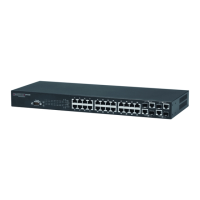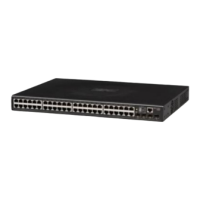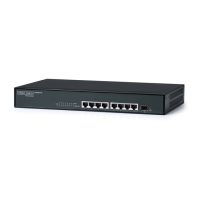C
HAPTER
34
| VLAN Commands
Configuring IEEE 802.1Q Tunneling
– 796 –
COMMAND MODE
Normal Exec, Privileged Exec
EXAMPLE
The following example shows how to display information for VLAN 1:
Console#show vlan id 1
VLAN ID: 1
Type: Static
Name: DefaultVlan
Status: Active
Ports/Port Channels : Eth1/ 1(S) Eth1/ 2(S) Eth1/ 3(S) Eth1/ 4(S) Eth1/ 5(S)
Eth1/ 6(S) Eth1/ 7(S) Eth1/ 8(S) Eth1/ 9(S) Eth1/10(S)
Console#
CONFIGURING IEEE 802.1Q TUNNELING
IEEE 802.1Q tunneling (QinQ tunneling) uses a single Service Provider
VLAN (SPVLAN) for customers who have multiple VLANs. Customer VLAN
IDs are preserved and traffic from different customers is segregated within
the service provider’s network even when they use the same customer-
specific VLAN IDs. QinQ tunneling expands VLAN space by using a VLAN-in-
VLAN hierarchy, preserving the customer’s original tagged packets, and
adding SPVLAN tags to each frame (also called double tagging).
This section describes commands used to configure QinQ tunneling.
General Configuration Guidelines for QinQ
1. Configure the switch to QinQ mode (dot1q-tunnel system-tunnel-
control).
2. Create a SPVLAN (vlan).
3. Configure the QinQ tunnel access port to dot1Q-tunnel access mode
(switchport dot1q-tunnel mode).
Table 108: 802.1Q Tunneling Commands
Command Function Mode
dot1q-tunnel system-
tunnel-control
Configures the switch to operate in normal mode or
QinQ mode
GC
switchport dot1q-tunnel
mode
Configures an interface as a QinQ tunnel port IC
switchport dot1q-tunnel
tpid
Sets the Tag Protocol Identifier (TPID) value of a
tunnel port
IC
show dot1q-tunnel Displays the configuration of QinQ tunnel ports PE
show interfaces
switchport
Displays port QinQ operational status PE

